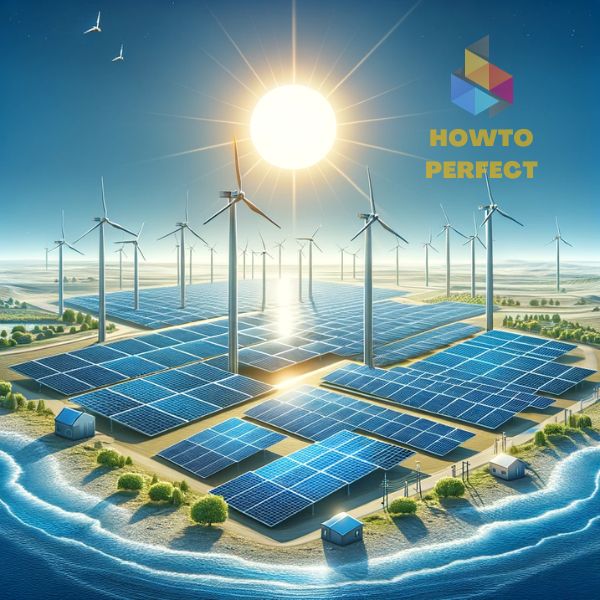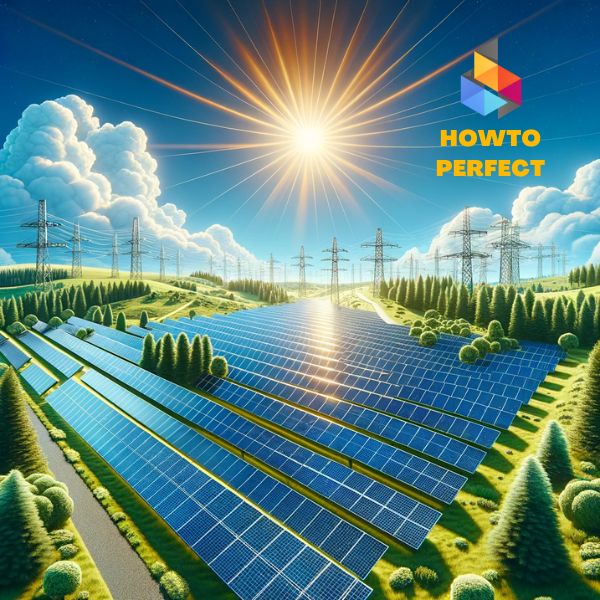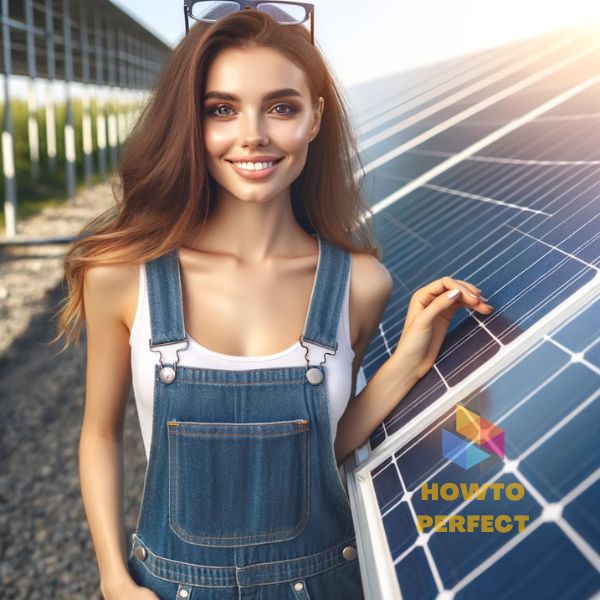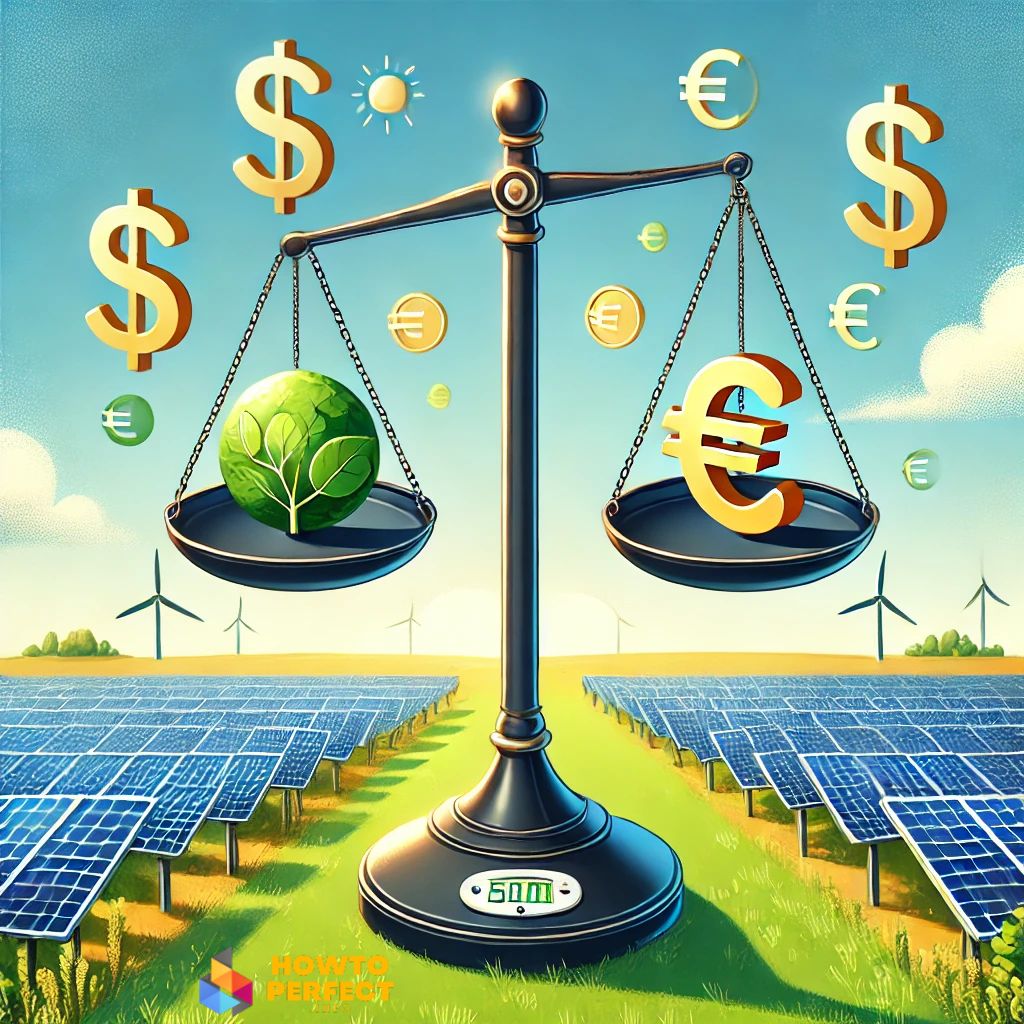Balancing Cost, Efficiency, and Sustainability in Solar Power“ delves into the intricate balance of cost, efficiency, and sustainability in the realm of solar power solutions. It aims to guide readers through the complexities of photovoltaic (PV) systems, addressing key factors that influence their performance and cost-effectiveness. The focus is on how to optimize PV solutions to meet the growing demands for sustainable energy while also considering economic viability and technological advancements. This article is essential for anyone interested in understanding and implementing effective and sustainable solar energy solutions.
Table of Contents
ToggleIntroduction to PV Solutions
Briefly introduce what PV (Photovoltaic) solutions are
Photovoltaic (PV) solutions represent a cornerstone in the world of renewable energy, offering a sustainable and increasingly cost-effective way to harness solar power. These systems convert sunlight directly into electricity using solar panels made of semiconductor materials. The beauty of PV technology lies in its versatility and scalability, ranging from small, rooftop installations to large, utility-scale solar farms.
As global awareness and demand for clean energy grow, PV solutions stand at the forefront, offering a viable alternative to traditional energy sources, significantly reducing carbon footprints and contributing to environmental preservation. This introduction aims to unravel the basics of PV technology and its impact on our journey towards a greener future.
Importance in the context of renewable energy
Photovoltaic (PV) solutions are pivotal in the global shift towards renewable energy, offering a clean, sustainable alternative to fossil fuels. As the world grapples with the urgent need to reduce greenhouse gas emissions, PV technology stands out for its ability to generate electricity without harmful emissions. The role of solar power in mitigating climate change is invaluable, particularly as solar panels convert sunlight, a limitless resource, into electricity. This not only helps in conserving our planet’s finite resources but also reduces our dependency on traditional energy sources that are major contributors to global warming.
The integration of PV solutions into the energy mix is essential in achieving the goals set by various international accords, such as the Paris Agreement. By harnessing the power of the sun, solar energy contributes significantly to reducing the carbon footprint of energy generation. Moreover, advancements in PV technology have led to more efficient solar panels, making solar energy one of the most rapidly growing renewable energy sources worldwide. This growth is a testament to the increasing recognition of solar power’s potential in driving sustainable development and promoting environmental stewardship.
In the broader context of energy sustainability, PV solutions are more than just an alternative; they are a necessity for a sustainable future. With the ongoing decline in costs of solar installations and improvements in energy storage, solar power is becoming increasingly accessible and practical. This democratization of energy not only empowers communities but also plays a critical role in ensuring energy security, reducing energy poverty, and fostering economic growth in a sustainable manner. The importance of PV solutions in the realm of renewable energy cannot be overstated, as they pave the way for a cleaner, greener, and more sustainable world.
Technological Overview of PV Systems
Components of a PV system
Photovoltaic (PV) systems represent a marvel of modern engineering, comprising several key components that work in unison to convert sunlight into usable electricity. At the heart of these systems are the solar panels, which are made up of numerous photovoltaic cells. These cells are designed to capture solar radiation and convert it into direct current (DC) electricity. The efficiency and quality of these solar panels play a crucial role in the overall performance and output of the PV system, making them a primary focus in the realm of solar energy technology.
Another vital component of PV systems is the inverter. Its primary function is to convert the DC electricity generated by the solar panels into alternating current (AC) electricity, which is the standard electrical form used in homes and businesses. Inverters are crucial for integrating solar energy into the existing power grid and ensuring that the energy produced by the PV system is compatible with common electrical appliances. The evolution of inverter technology, including micro-inverters and string inverters, has significantly improved the efficiency and reliability of solar power systems.
Additionally, PV systems include mounting systems, electrical wiring, and solar batteries for energy storage. Mounting systems ensure that solar panels are positioned to maximize sun exposure, while the electrical wiring connects all components of the PV system for smooth operation. Solar batteries have become increasingly important, allowing for the storage of excess energy generated during peak sunlight hours for use during periods with less sunlight or at night. This aspect of PV technology is rapidly advancing, enhancing the versatility and self-sufficiency of solar energy systems. Together, these components underscore the technological sophistication behind PV solutions, paving the way for a future where renewable energy is not just viable but preferable.
How PV Systems Convert Solar Energy into Electricity
The process by which Photovoltaic (PV) systems convert solar energy into electricity is a fascinating interplay of physics and engineering. The core of this process lies in the photovoltaic effect, a phenomenon where solar cells, typically made of semiconductor materials like silicon, absorb photons from sunlight and release electrons. These freed electrons flow through the material to produce direct current (DC) electricity. Each solar cell generates a small amount of electricity, but when combined in panels and connected in arrays, they produce a significant electrical output, suitable for powering homes, businesses, or even feeding into the power grid.
At the microscopic level, the semiconductor materials in solar cells are designed with a positive and a negative layer to create an electric field, much like in a battery. When sunlight hits these cells, the energy from the photons causes electrons to be knocked loose from their atoms within the semiconductor material. This release of electrons, and their movement towards the opposite side of the electric field, creates the flow of electrical current. This is where the magic of solar energy conversion happens, transforming radiant sunlight into a form of energy that can power our everyday lives.
The efficiency of this conversion process is constantly being improved through technological advancements. Modern PV systems have become more efficient at capturing a broader spectrum of sunlight and converting it into electricity. Innovations in materials, cell design, and manufacturing techniques have led to higher solar panel efficiencies, meaning more electricity can be generated from the same amount of sunlight. This increased efficiency is crucial for maximizing the energy yield from PV systems, especially in areas with limited space or varying sunlight conditions. Understanding these technological nuances is key to appreciating the potential and challenges of harnessing solar energy through PV systems.
Benefits of PV Solutions
Environmental Impact and Sustainability of PV Solutions
The environmental impact of Photovoltaic (PV) solutions is profoundly positive, marking a significant shift in how we generate and consume energy. One of the most notable benefits is the reduction of greenhouse gas emissions. Unlike fossil fuels, PV systems produce electricity without emitting carbon dioxide or other harmful pollutants. This clean energy production plays a crucial role in combating climate change, as it directly decreases the carbon footprint associated with energy generation. By replacing or supplementing traditional power sources with solar energy, we can significantly mitigate the adverse effects of global warming and contribute to a healthier, more sustainable planet.
Another environmental benefit of PV solutions is the reduction in water usage. Traditional power generation methods, particularly those involving thermal power plants, require substantial amounts of water for cooling purposes. In contrast, solar energy generation involves no water consumption, making PV systems an ideal choice in water-scarce regions. This aspect of solar power is particularly vital in the context of growing global concerns over water scarcity and the need for more water-efficient energy sources. By adopting solar power, we not only save on carbon emissions but also conserve one of our most precious resources – water.
Moreover, PV solutions contribute to the preservation of ecosystems and biodiversity. Solar farms can be installed on non-arable land or integrated into buildings, minimizing land use conflicts and the impact on natural habitats. The modular nature of solar panels also allows for scalable installations, from small rooftop systems to large solar farms, adapting to different environmental settings without significant disruption to local ecosystems. This harmonious integration with the environment underscores the role of PV solutions in fostering a balance between energy production and ecological conservation, making them a key component in the transition to a more sustainable and environmentally responsible energy future.
Cost Savings and Enhanced Efficiency with PV Solutions
Photovoltaic (PV) solutions not only contribute significantly to environmental sustainability but also offer substantial cost savings and enhanced efficiency in energy production. The initial investment in solar panel installation is increasingly becoming cost-effective due to the declining costs of solar technology and the rising efficiency of solar panels. Over time, the savings on electricity bills become quite substantial, as solar power allows homeowners and businesses to generate their own free energy from the sun. Additionally, many governments offer incentives, such as tax credits or feed-in tariffs, which further reduce the overall cost and accelerate the return on investment for PV systems.
The efficiency of PV solutions has seen remarkable improvements over the years. Modern solar panels are capable of converting a higher percentage of solar radiation into electricity, meaning more power can be generated from a smaller area. This efficiency leap is pivotal, especially in urban settings where space is at a premium. Moreover, technological advancements in energy storage systems, such as batteries, allow for the effective storage of excess solar energy, ensuring a steady power supply even when sunlight is not available. This reliability and efficiency of solar energy systems make them a highly practical and sustainable solution for a wide range of energy needs.
In the context of long-term financial planning, PV solutions present a wise investment. The durability and low maintenance requirements of solar panels mean they can provide clean, efficient energy for decades, offering long-term energy security and price stability. This is particularly valuable in an era of fluctuating energy prices and growing concerns over energy availability. By reducing dependency on utility companies and fossil fuels, solar power users can enjoy a degree of financial autonomy and predictability in energy costs. The combined cost savings and efficiency of PV solutions make them not just an environmentally conscious choice, but a financially smart one as well.
Latest Innovations in PV Technology
Advancements in PV Materials and Efficiency: Pioneering the Future of Solar Technology
The Latest Innovations in PV Technology have primarily centered around advancements in PV materials and efficiency, revolutionizing how solar energy is harnessed and utilized. One of the most significant developments has been in the realm of solar cell materials. Researchers and manufacturers have been exploring beyond traditional silicon-based solar cells to alternative materials like perovskite. Perovskite solar cells are not only cheaper to produce but also demonstrate higher efficiency in converting solar energy into electricity. This breakthrough in materials science offers the potential for more cost-effective and efficient solar panels, paving the way for wider adoption of solar energy.
Another key area of innovation is in increasing the efficiency of solar panels. Efforts have been focused on enhancing the design and structure of solar cells to capture more sunlight and convert it into electricity more efficiently. This includes developing bifacial solar panels, which can absorb sunlight from both sides, and incorporating advanced techniques like Maximum Power Point Tracking (MPPT) in solar inverters to optimize power extraction. As a result, modern PV systems are not only more powerful but also more space-efficient, making them ideal for both large-scale solar farms and small-scale residential installations.
Moreover, the integration of Artificial Intelligence (AI) and Internet of Things (IoT) technologies in PV solutions is also a game-changer. AI algorithms can predict solar energy generation patterns, optimize energy distribution, and perform predictive maintenance, thereby enhancing the overall performance and lifespan of PV systems. IoT, on the other hand, enables real-time monitoring and control of solar installations, ensuring they operate at peak efficiency. These technological innovations are instrumental in making PV systems smarter, more responsive, and more efficient, solidifying their role as a key player in the future of renewable energy.
Emerging Trends and Future Prospects in PV Technology
The landscape of Photovoltaic (PV) Technology is continuously evolving, with emerging trends shaping its future. One of the most promising developments is the integration of PV systems with smart grid technology. This integration allows for more efficient management and distribution of solar energy, adapting to the energy demands of the grid in real-time. This smart connectivity not only enhances the efficiency of energy usage but also paves the way for more robust and resilient energy systems. Another trend gaining momentum is the use of floating solar farms, which utilize water bodies for installing solar panels, thereby conserving valuable land space and reducing water evaporation from these bodies.
In the near future, the focus on building-integrated photovoltaics (BIPV) is expected to rise significantly. BIPV seamlessly integrates solar cells into building materials like windows, roofs, or facades, turning entire buildings into energy-generating entities. This approach not only enhances the aesthetic appeal of solar energy solutions but also opens up new avenues for architectural innovation. Additionally, the continuous research into more efficient and less costly solar cell materials, such as perovskite, promises to make solar energy more accessible and affordable, potentially leading to a surge in global solar energy adoption.
The prospect of combining PV technology with emerging technologies like nanotechnology and quantum dots also presents an exciting future. These technologies could lead to the development of ultra-thin, flexible solar panels that are more efficient and versatile than current models. This could revolutionize the application of solar energy, making it feasible for a wider range of uses, from wearable technology to transport. The ongoing advancements and emerging trends in PV technology not only highlight its potential as a key player in the renewable energy sector but also underscore its role in driving sustainable and innovative solutions for the future.

Case Studies and Real-World Applications
Showcasing Successful PV Solution Implementations
GreenBuddies, a company specializing in PV construction and EV charging, provides a compelling example of successful PV solution implementations in various real-world applications.
GreenBuddies has an impressive track record, having completed over 1000 MWp of PV plants in the past five years. This achievement demonstrates their capacity to handle large-scale projects effectively. They have been involved in a wide range of projects, including the development, financing, and building of solar projects across Europe. Their team’s expertise allows them to identify potential locations for solar power facilities, ensuring optimal placement and performance of the installations.
One of their notable projects includes a partnership with PVI GmbH, a solar solutions developer. This partnership exemplifies GreenBuddies‘ commitment to pushing the boundaries in the solar energy sector. They specialize in EPC contracts, providing complete turnkey solutions from design through component supply to construction. Their experience is particularly strong in large-scale rooftop PV installations. This partnership led to the completion of their first joint project at the end of 2022, a 4.15 MWp PV plant in Klagenfurt. Following this, they signed a framework agreement for further PV projects, focusing on rooftop installations.
Additionally, GreenBuddies has engaged in operations and maintenance of PV plants, a critical aspect of ensuring long-term efficiency and performance. Their approach includes remote monitoring, supervision, and control of PV plants, ensuring they operate at peak performance.
These examples from GreenBuddies highlight the importance of expertise, thorough planning, and maintenance in the successful implementation of PV solutions. Such real-world applications underscore the potential and versatility of PV technology in contributing to sustainable renewable energy production.
For more detailed information about GreenBuddies projects and expertise in PV solutions, you can visit their website here.
Assessing the Impact of PV Solutions on Businesses and Communities
The impact of PV solutions on businesses and communities has been significant, as evidenced by various case studies. For instance, Cedar Falls Utilities launched a community solar program to make renewable energy accessible and affordable. The program offered customers a 20-year lease on a portion of a solar panel, with a payback estimated within 15 years, demonstrating the financial viability of such initiatives. This initiative not only sold out quickly but also garnered a waiting list, showing the high demand for accessible renewable energy solutions.
Joju Solar presents another example, where they have been involved in diverse PV projects that positively impact local communities. Their projects range from installing solar roofs on historical buildings to large community solar programs. These initiatives highlight the versatility of solar energy applications and the benefits they offer to different sectors, including residential, commercial, and public entities.
These case studies exemplify how PV solutions are not just environmentally beneficial but also economically viable, providing long-term financial benefits to participants. They also demonstrate the adaptability of solar technology, capable of being implemented in various settings, from residential rooftops to communal lands, contributing to the broader adoption of sustainable energy practices.
Choosing the Right PV Solution
Key Factors to Consider When Selecting a PV Solution: Size, Location, and Cost
When Choosing the Right PV Solution, several key factors need to be considered to ensure optimal performance and value. One of the most crucial factors is the size of the PV system. This depends on various aspects such as energy needs, available space for installation, and budget. A larger system will generate more electricity but will also require more space and a higher initial investment. It’s essential to assess energy consumption patterns to determine the right size that balances energy requirements with space and cost constraints.
Location also plays a significant role in determining the effectiveness of a PV system. Factors like the geographical location, the amount of sunlight received, and the angle of roof or installation surface can significantly impact the efficiency of solar panels. Areas with higher solar irradiance will yield more electricity from the same size solar panels compared to regions with less sunlight. Additionally, considerations such as local climate, potential shading from nearby buildings or trees, and local regulations need to be factored in when choosing the right PV solution.
Lastly, cost is a vital consideration. While the upfront cost of PV systems has been decreasing, it remains a significant investment. It’s important to consider not only the initial cost but also potential savings in energy bills, maintenance costs, and incentives like tax credits or rebates. A thorough cost-benefit analysis, taking into account long-term energy savings and any available financial incentives, will help in making an informed decision. Balancing these key factors – size, location, and cost – is essential in selecting the PV solution that best fits individual needs and maximizes the return on investment.
Essential Tips for Selecting the Right PV Solution Provider
When Choosing the Right PV Solution, selecting the right provider is as crucial as the technology itself. The first tip for selecting a provider is to assess their expertise and experience in the field of solar energy. A provider with a solid track record and positive customer feedback indicates reliability and quality service. It’s essential to choose a company that not only installs but also offers maintenance and support for the PV systems. This ensures long-term efficiency and functionality of your solar energy investment.
Another important consideration is the quality of products offered by the provider. High-quality solar panels and components may come at a higher initial cost but are critical for the durability and efficiency of the system. It’s advisable to opt for providers that offer products with strong warranties and are known for their longevity and performance. Additionally, the provider should be up-to-date with the latest technology and innovations in solar energy, enabling access to the most efficient and sustainable solutions available.
Lastly, it’s crucial to consider the provider’s customer service and support. A provider that offers comprehensive consultation, clear communication, and transparent pricing is preferable. It’s important to ensure that they provide thorough guidance on the operation and maintenance of the system, as well as assistance with any permits or paperwork required. Good customer service also includes post-installation support, addressing any concerns or issues that may arise. The right provider will not only facilitate a smooth installation process but also ensure that you are equipped to make the most of your PV solution.

Conclusion: Key Takeaways from the Exploration of PV Solutions The future of PV solutions in renewable energy
In conclusion, the journey towards implementing the perfect PV solution involves a comprehensive understanding of the various aspects that influence its performance, sustainability, and value. From considering the size, location, and cost of the system, to keeping abreast of the latest advancements in PV materials and technology, each element plays a vital role in maximizing the benefits of solar energy. Furthermore, choosing the right provider, one that not only offers quality products and services but also demonstrates expertise and commitment to customer satisfaction, is crucial in ensuring the long-term success of your solar energy investment.
The future of renewable energy, particularly solar power, is bright and full of potential. With ongoing innovations making PV solutions more efficient and cost-effective, and a growing awareness of the environmental and economic benefits they offer, solar energy stands at the forefront of sustainable development. As we move forward, the adoption of PV solutions is not just an environmental imperative but also a practical choice for energy independence and resilience. This journey towards a solar-powered future is one that promises a cleaner, greener, and more sustainable world for generations to come.
Envisioning the Future: The Role of PV Solutions in Renewable Energy
In concluding our exploration of PV solutions, it’s clear that their role in the renewable energy landscape is not just prominent but also pivotal for the future. As we face increasing environmental challenges and a pressing need for sustainable energy sources, PV technology stands as a beacon of hope and innovation. The continuous advancements in efficiency, coupled with the decreasing costs of solar installations, are setting the stage for a future where solar energy is not only accessible but also a dominant force in global energy production. The integration of PV solutions with emerging technologies like AI and smart grids is further enhancing their potential, making solar energy more efficient, reliable, and integrated into our daily lives.
Looking ahead, the future of renewable energy is intrinsically tied to the evolution and adoption of PV solutions. With their ability to harness the sun’s abundant and clean energy, they offer a solution that aligns with global efforts to combat climate change and reduce reliance on fossil fuels. The potential for PV technology to transform communities, empower individuals, and revolutionize industries is immense. As we continue to innovate and embrace these solutions, we move closer to a sustainable future, underpinned by clean, renewable energy that benefits both the planet and its inhabitants.
Sources: How to Perfect Photovoltaics, Center for Sustainable Systems, University of Michigan, U.S. Department of Energy – Solar Energy Technologies Office (SETO), International Energy Agency (IEA) – Photovoltaic Solar Power Analysis, IEA – Solar Technology Deployment and Manufacturing, U.S. Department of Energy – How Does Solar Work?, U.S. Department of Energy – Solar Photovoltaic Cell Basics, MIT Climate Portal – Solar Energy, Nature – Solar Energy and Photovoltaic Technology, Nature – A New Kind of Solar Cell, U.S. Energy Information Administration (EIA) – Photovoltaics and Electricity, SEO Optimalizace
For an insightful exploration into the world of Power Purchase Agreements (PPAs) and their impact on the renewable energy landscape, be sure to read our in-depth article at howtoperfect.info. Discover how PPAs are shaping the future of energy procurement and the role they play in advancing sustainable energy solutions.
Discussion
As we conclude this exploration of the dynamic world of Marketing, we invite you to share your experiences, insights, and tips in the comments below.
- Have you encountered specific challenges or discovered effective strategies in your journey with digital marketing? We encourage you to contribute to our community by sharing your valuable expertise. If you have questions or seek advice on any aspect related to Marketing, feel free to ask.
Let’s foster a collaborative space where knowledge is shared, questions are answered, and the community thrives. Your input can be instrumental in helping others navigate the nuances of Digital marketing and unlock new levels of success in the realm of online marketing.







